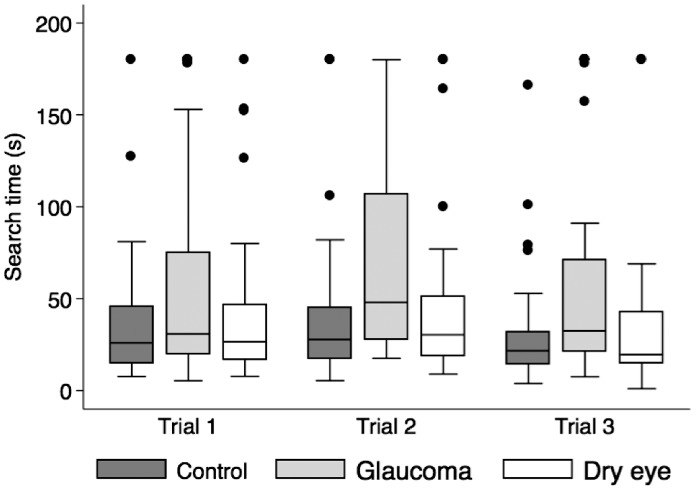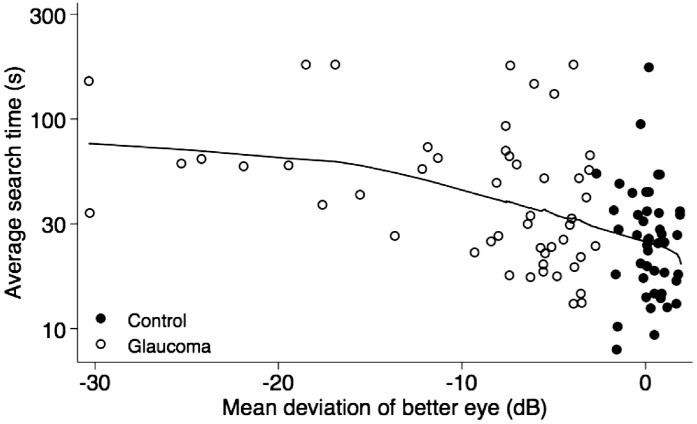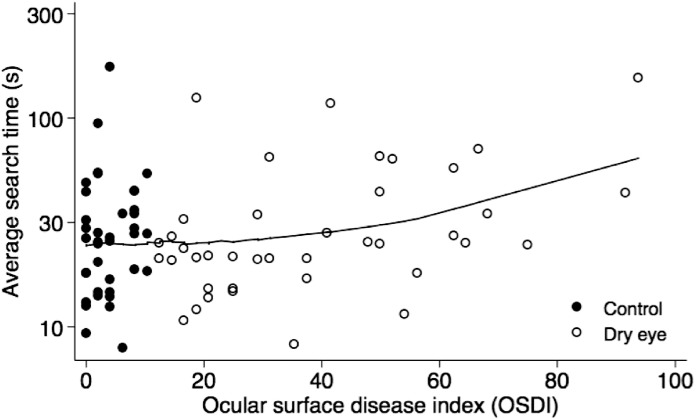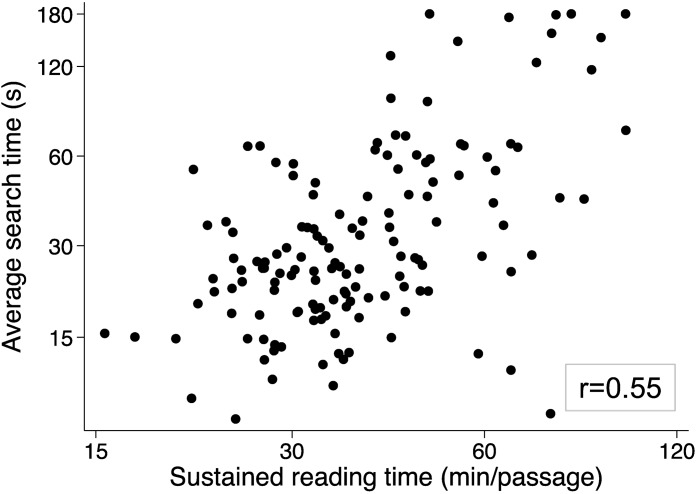Abstract
Purpose
We determine if visual field loss from glaucoma and/or measures of dry eye severity are associated with difficulty searching, as judged by slower search times on a text-based search task.
Methods
Glaucoma patients with bilateral visual field (VF) loss, patients with clinically significant dry eye, and normally-sighted controls were enrolled from the Wilmer Eye Institute clinics. Subjects searched three Yellow Pages excerpts for a specific phone number, and search time was recorded.
Results
A total of 50 glaucoma subjects, 40 dry eye subjects, and 45 controls completed study procedures. On average, glaucoma patients exhibited 57% longer search times compared to controls (95% confidence interval [CI], 26%–96%, P < 0.001), and longer search times were noted among subjects with greater VF loss (P < 0.001), worse contrast sensitivity (P < 0.001), and worse visual acuity (P = 0.026). Dry eye subjects demonstrated similar search times compared to controls, though worse Ocular Surface Disease Index (OSDI) vision-related subscores were associated with longer search times (P < 0.01). Search times showed no association with OSDI symptom subscores (P = 0.20) or objective measures of dry eye (P > 0.08 for Schirmer's testing without anesthesia, corneal fluorescein staining, and tear film breakup time).
Conclusions
Text-based visual search is slower for glaucoma patients with greater levels of VF loss and dry eye patients with greater self-reported visual difficulty, and these difficulties may contribute to decreased quality of life in these groups.
Translational Relevance
Visual search is impaired in glaucoma and dry eye groups compared to controls, highlighting the need for compensatory strategies and tools to assist individuals in overcoming their deficiencies.
Keywords: glaucoma, dry eye, visual search, visual fields
Introduction
Visual search, the process of looking for a specific target within a larger scene, has a key role in our everyday lives, allowing us to search for a variety of objects, such as computer icons, street signs, and medication names on labels.1 The search process likely involves peripheral and central vision, with peripheral vision used to scan for targets, after which point central vision is used to examine targets in detail and determine if additional scanning is necessary.1,2 As such, search difficulty may occur in eye diseases that affect either peripheral or central vision.
Several validated questionnaires and functional tests have incorporated items relating to visual search, highlighting its importance. The National Eye Institute Visual Function Questionnaire asks about difficulty finding items on a crowded shelf, while the Glaucoma Quality of Life Questionnaire asks about difficulty finding dropped objects. Likewise, the Assessment of Disability Related to Vision metric directly observes and grades the performance of nine tasks, including one task involving object location.3 However, these questions or tasks are imbedded within larger measures and do not isolate the impact of vision loss on difficulty with visual search.
Several age-related eye diseases, including glaucoma and dry eye, have been associated with difficulties in search-related tasks. With regards to glaucoma, a few studies have directly investigated visual search performance, with varying results. Smith et al.4 demonstrated that patients with glaucomatous visual field defects exhibit prolonged search times when finding target items in everyday photographs; however, they showed no greater difficulty in searching for specific symbols within an image. Sippel et al.5 found increased search times in glaucoma patients searching for items in a supermarket, whereas Wiecek et al.6 found no impairment of search speed in glaucoma patients searching for a target within a natural scene. The multiplicity of search tasks used in these studies demonstrates the variety of areas in which visual searching is used in daily life and the importance of assessing the impact of eye disease on different types of search tasks.
Dry eye, on the other hand, has been associated with self-reported impairment in many daily tasks, including reading, using a computer, watching television, and driving,7 all of which require some component of search. These measures are, in fact, a component of the Ocular Surface Disease Index (OSDI) used to evaluate dry eye severity.8 However, to our knowledge no quantitative measures of visual function impairment have been studied in dry eye. Unlike glaucoma, dry eye does not quantifiably alter the visual field, yet patients self-report decreased visual ability. Given that dry eye is ubiquitous and often seen in the same elderly population as those with glaucoma, an understanding of what function is affected in dry eye is important.
We examined the impact of visual field loss from glaucoma on a text-based search task, and also investigated whether this specific search task is affected by measures of dry eye – a condition for which performance measures largely are lacking. Given the visual impairment and vision complaints associated with these eye diseases, we hypothesized that both disease groups would exhibit slower text-based searches compared to visually normal controls, and that search times would increase with disease severity. Text searching is an integral part of many daily tasks, and our understanding of the impact of glaucoma and dry eye on such searching is important in furthering our understanding of the functional consequences of these diseases and developing objective measures to assess the impact of treatments on function.
Methods
The study protocol was submitted prospectively and approved by the Johns Hopkins University institutional review board, and was performed in accordance with the Declaration of Helsinki. Study participants signed written informed consent and completed procedures between July 2009 and April 2011.
Study Subjects
This cross-sectional study included subjects aged 50 and older recruited from the glaucoma and dry eye clinics at the Wilmer Eye Institute, Johns Hopkins Hospital, Baltimore, Maryland. Individuals were eligible if they were able to communicate in English and self-reported to be literate. Subjects were excluded if they had had ocular surgery in the last two months, or any laser procedure in the week before enrollment.
Three study groups were included: individuals with normal vision followed for suspected glaucoma (controls), patients with a known history of glaucoma with documented bilateral visual field (VF) loss (glaucoma subjects), and patients with clinically significant dry eye (dry eye subjects).
Glaucoma subjects had a diagnosis of primary open-angle, primary angle-closure, pseudoexfoliation, or pigment dispersion glaucoma. They also were required to meet the following criteria in both eyes: a 24-2 VF in the 15 months before recruitment with a mean deviation (MD) worse than −3 dB; a glaucoma hemifield test (GHT) read as borderline, outside normal limits, or general reduction of sensitivity in both eyes; and a corrected visual acuity of at least 20/40 in one eye. Analyzed VFs were performed in both eyes over the central 24° using a size III stimulus and the Swedish interactive thresholding algorithm standard testing program. Testing was conducted on a Humphrey HFA2 machine (Carl Zeiss Meditec, Inc., Dublin, CA).
Dry eye subjects were seen for primary complaints of dry eye (foreign body sensation, burning, stinging, dryness, soreness, heaviness of the lids, photophobia, or ocular fatigue). Subjects were required to measure 13 or higher on the OSDI, and have clinically significant dry eye (defined as dry-eye related complaints with a Schirmer's test result without anesthesia ≤7 mm at 5 minutes in either eye and/or bulbar conjunctival staining with lissamine green ≥1 in either eye according to the Oxford scale) to be included in the study. Dry eye patients were on topical treatment as needed when enrolled and continued treatment through the study. Subjects also were required to have a corrected visual acuity of at least 20/40 in at least one eye.
Controls had ocular hypertension or other reasons for suspected glaucoma, and were required to meet the following criteria: one or more VFs in the 15 months before recruitment; MD better than −5 dB in both eyes; GHT read as borderline, within normal limits, or general reduction of sensitivity in both eyes; and corrected visual acuity of at least 20/40 in both eyes. In analyses comparing dry eye patients to controls, the control group was further restricted to patients with an OSDI score ≤12.
Evaluation of Search Time
Search time was defined as the time required to complete a binocular search task. Subjects were read the name of the company whose number they were to find, handed a 20-page paper excerpt of the Yellow Pages, and timed until they correctly read aloud the given company's phone number. Three consecutive, independent trials were performed for each subject using a different excerpt and company name for each trial, and search time was recorded up to a maximum of 180 seconds per trial. Errors also were recorded for each trial.
Measurement of Vision, Covariates, and Reading Speed
VFs were obtained as noted above. The greater (less negative) MD between the two eyes was used for analysis. In addition, sensitivities of spatially corresponding points from VFs of both eyes were merged to obtain an integrated VF (IVF) mean sensitivity as described previously9,10 for the peripheral, central, superior, inferior, and full VFs. The maximum sensitivity between the right and left eyes was taken as the sensitivity for each spatially corresponding point, converted from decibel sensitivity to raw sensitivity values, averaged over all points in the region of interest, and transformed back to decibel values to obtain mean sensitivity values. The central field included the central four points (found within 5° of fixation), and the peripheral field included all points at least 10° from fixation along the x- or y-axis (i.e., all points except the 4 central points and the 10 points forming a box around these central 4 points).
Reading acuity was assessed binocularly using the MNRead acuity chart as described previously and converted into negative logMAR units.11 Contrast sensitivity (CS) was measured using the Pelli-Robson Chart and the number of letters read correctly was transformed into logCS. The presence of significant lenticular changes or posterior capsular opacification (PCO) also was assessed as described previously.12,13
The OSDI questionnaire was used to evaluate dry eye severity. In addition to a total OSDI score, an OSDI vision-related subscore and OSDI ocular symptom-related subscore were computed separately from the questionnaire, as described previously.14 The vision subscore examined impairment in visual functioning as defined by self-reported blurred vision, poor vision, and limitations with reading, night driving, computer use, and watching television. The symptom subscore assessed self-reported symptoms related to ocular discomfort as measured by light sensitivity, grittiness or pain/soreness, and discomfort in windy, dry, or air-conditioned environments. Tear film breakup time (TBUT), corneal staining, and Schirmer's test without anesthesia were performed as described previously.14
Chart review and standardized questionnaires were used to obtain data on other possible covariates, including age, sex, race/ethnicity, education, and employment status. Cognitive ability was assessed using the Mini-Mental State Examination (MMSE).15 A positive response to any question on part D of the General Health Questionnaire was interpreted to indicate presence of depressive symptoms.16
Sustained reading time was defined as the time required to read a standardized 7,600-word passage, as described previously, and used in correlation analyses to determine to what extent reading and search are related.12,13
Statistical Methods and Programming
Demographics, health, and vision differences across groups were analyzed using the Student's t-test for normally-distributed continuous variables and the χ2 test for categorical variables.
Search times in the glaucoma and dry eye groups were compared to the relevant control sample using t-tests and multivariate regression models using generalized estimating equations to account for correlations across same-subject search trials. A logarithmic transformation was applied to search time to ensure normal distribution of model residuals. Covariates included in multivariate models (including passage number) were identified using univariate analyses, and included in multivariate models if they demonstrated P values <0.1. Regression coefficients were exponentiated to yield the percent change in search time associated with each model element.
Additional models evaluated if glaucoma or dry eye severity was associated with slower searching (longer search times). Glaucoma severity was judged via VF MD in the better eye, contrast sensitivity, and visual acuity. Better eye MD was chosen given prior evidence demonstrating similar functional implications for better eye MD and measures of IVF damage across the two eyes.17 The impact of specific regions of the VF was examined using the IVF of the peripheral, central, superior, inferior, and full VFs. Dry eye severity was assessed using OSDI scores/subscores and objective measures of dry eye (worse-eye TBUT, corneal staining, and Schirmer's test).
Post-hoc effect sizes were calculated using a 1-sided t-test with 80% power and α = 0.05. The mean of the logarithm of the average search time in the appropriate control group and standard deviations of the mean of logarithm of the average search times in the control and experimental groups were used. The calculations demonstrated that a 45.6% increase in mean search time between the control and glaucoma groups could be detected and 44.9% increase in mean search time between control and dry eye groups could be detected with the same power and significance.
Data analyses were performed with STATA version 14 (STATA Corp., College Station, TX).
Results
Study Population
A total of 45 controls, 49 glaucoma subjects, and 41 dry eye subjects completed the study procedures. No demographic or health differences were noted between the glaucoma and control groups. Compared to controls, glaucoma subjects had greater better-eye VF loss (VF MD −9.3 vs. 0.2, P < 0.001), worse reading acuity (logMAR 0.09 vs. 0.01, P < 0.001), and worse CS (logCS 1.68 vs. 1.93; Table 1). The 48 glaucoma subjects with complete 24-2 VFs had lower IVF sensitivities compared to controls in the peripheral (30.0 vs. 23.7, P < 0.001), central (32.8 vs. 28.0, P < 0.001), superior (30.3 vs. 23.7, P < 0.001), inferior (31.1 vs. 25.7, P < 0.001), and full (30.7 vs. 25.2, P < 0.001) VFs.
Table 1.
Characteristics of Study Subjects by Disease Status
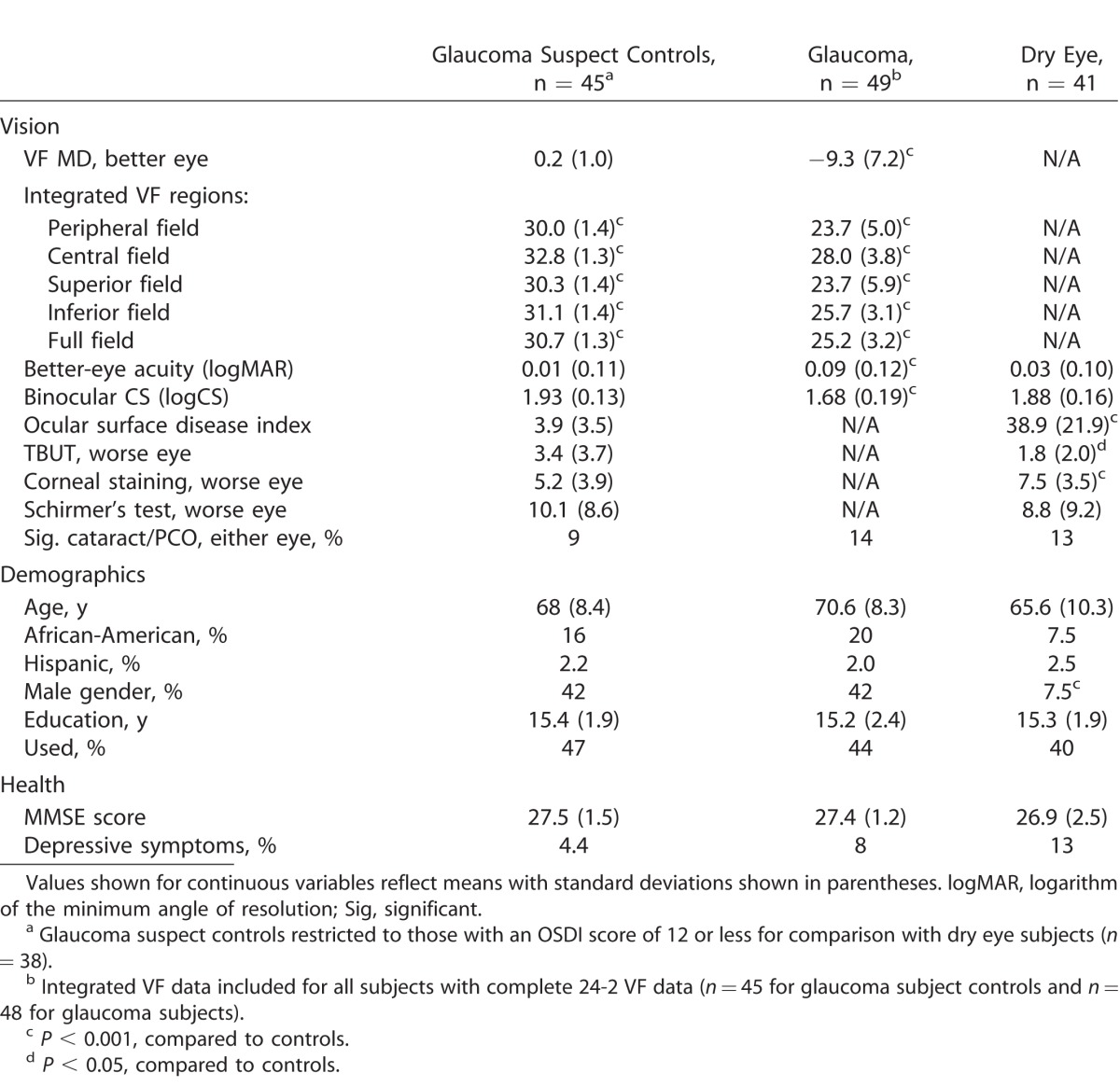
Dry eye patients were similar to the 38 controls demonstrating an OSDI ≤ 12, although there were fewer men in the dry eye group (7.5% vs. 42%, P < 0.001; Table 1). Total ODSI scores, worse-eye TBUT, and worse-eye corneal staining were significantly worse in the dry eye group compared to controls (P < 0.05 for all), but the groups did not differ with regards to worse-eye Schirmer's test results, reading acuity, or CS (P > 0.08 for all; Table 1). The glaucoma and dry eye groups had a similar frequency of significant cataract/PCO compared to controls (P > 0.63 for both).
Predictors of Search Time
Average search times in the full control group were 36.4 (95% confidence interval [CI], 26.5–46.2), 39.6 (95% CI, 28.1–51.1), and 29.3 (95% CI, 20.6–38.0) seconds for the three search trials, respectively. Glaucoma patients exhibited search times of 53.7 (95% CI, 40.2–69.3), 71.0 (95% CI, 55.2–86.8), and 57.3 (95% CI, 41.3–73.3) seconds, significantly longer than controls in the latter two trials (P < 0.001), but not the first (P = 0.07). Dry eye patients showed no statistically significant difference in search times compared to the 38 controls with an OSDI ≤12, requiring 41.7 (95% CI, 28.3–55.1), 44.5 (95% CI, 30.9–58.2), and 33.6 (95% CI, 21.5–45.7) seconds to complete each search task (P > 0.51 for all trials; Fig. 1). No errors in identification of the correct phone number were noted within any group.
Figure 1.
Yellow Pages search times for glaucoma suspect controls, glaucoma patients, and dry eye patients. Legend: Times shown for three independent search trials done on different Yellow Pages excerpts.
Multivariate modeling demonstrated that glaucoma was associated with a 57% longer search time compared to controls (95% CI, 26%–96%, P < 0.001). In separate models including glaucoma and control patients, and using a single visual measure meant to capture glaucoma severity, greater VF loss (21% longer search time per 5dB decrement; 95% CI, 12%–30%; P < 0.001), worse CS (12% longer per 0.1 logCS unit worse; 95% CI, 5%–18%; P < 0.001), and worse reading acuity (13% longer per 0.1 logMAR unit worse; 95% CI, 11%–25%; P = 0.026) were each associated with longer search times (Fig. 2; Table 2). The model with VF exhibited the greatest Wald χ2 (80.8, compared to 69.0 for CS, 53.9 for reading acuity, and 46.6 for covariates only).
Figure 2.
Relationship between average search time and VF MD in control and glaucoma subjects.
Table 2.
Predictors of Search Time, Multivariate Analysis
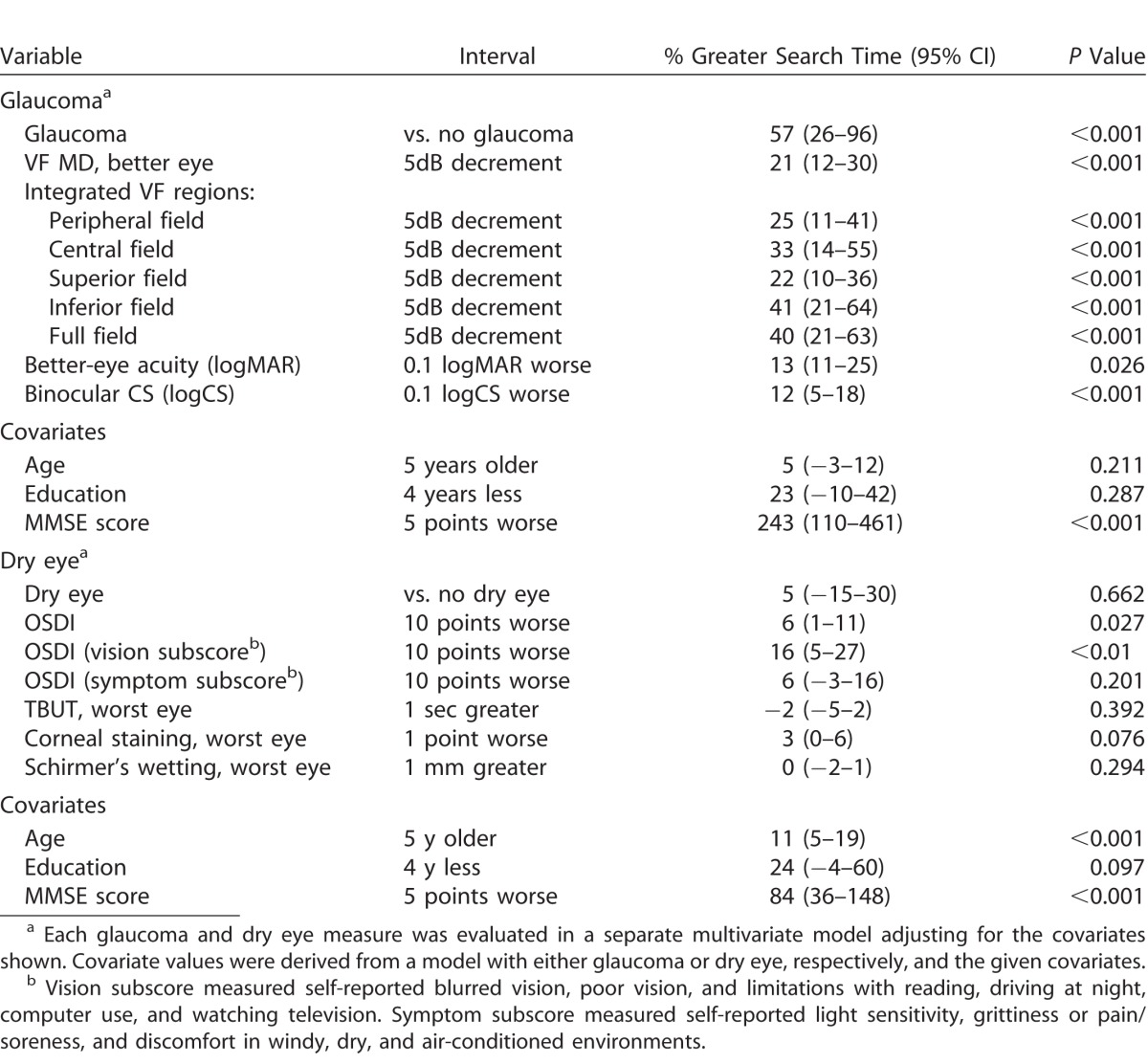
Separate models examining the impact of specific regions of the IVF showed increased search times associated with worse IVF sensitivities in the peripheral (25% longer per 5dB worse; 95% CI, 11%–41%; P < 0.001), central (33% longer per 5dB worse; 95% CI, 14%–55%, P < 0.001), superior (22% longer per 5dB worse; 95% CI, 10%–36%, P < 0.001), inferior (41% longer per 5dB worse; 95% CI, 21%–64%, P < 0.001), and full (40% longer per 5dB worse; 95% CI, 21%–63%, P < 0.001) VFs. The Wald χ2 values were comparable among models, but the models with the inferior and full VF were the highest (75.2 for inferior and 75.8 for full, compared to 67.7 for peripheral, 67.2 for central, and 68.5 for superior VF). Worse MMSE score also was associated with prolonged search (Table 2).
Multivariate models evaluating dry eye subjects and controls with an OSDI ≤12 were used to determine the relationship between dry eye measures and search time. The presence of dry eye alone was not associated with a statistically significant increase in search time compared to controls (5% longer search time; 95% CI, −15%–30%, P = 0.66). Worse OSDI symptom-related subscores (P = 0.20) and objective dry eye measures also failed to show associations with longer search times (P > 0.08 for all; Table 2). Longer search times were noted with worse total OSDI scores (6% longer per 10-point increase, 95% CI, 1%–11%, P = 0.03) and vision-related subscores (16% longer per 10-point increase; 95% CI, 5%–27%, P < 0.01; (Fig. 3). In additional analyses restricted to a single study group, worse OSDI vision subscores were associated with longer search times within the dry eye group (P < 0.001), but not within the control or glaucoma groups (P > 0.50 for both).
Figure 3.
Relationship between average search time and total OSDI scores in control and dry eye subjects.
The average search time across the three search trials had a moderate correlation with sustained reading time, with a coefficient of 0.55 for the full study group (Fig. 4). Similar correlations also were seen within each group (r = 0.45 for controls, r = 0.60 for glaucoma patients, r = 0.41 for dry eye patients).
Figure 4.
Correlation between average search time and sustained reading time measured in the same individuals.
Discussion
On average, glaucoma patients required greater search times than control patients with normal VFs when performing a text-based visual search task, and search times were longer for glaucoma patients with greater VF loss, suggesting that search tasks may become more difficult as glaucoma becomes more advanced. In the dry eye group, neither the presence of dry eye, objective dry eye measures, nor self-reported ocular surface symptoms were associated with impaired search, although longer search times were noted for patients with greater self-reported visual difficulty.
Dry eye has a significant impact on vision-related quality of life, although no studies describing its impact on visual search were identified using the MEDLINE (PubMed) database and the search terms: dry eye, visual search, and search.18 Dry eye patients as a group did not differ from controls in their search ability, although our sample size was likely not sufficient to detect a modest difference. Notably, worse total OSDI scores were associated with increased search times. When the total OSDI was split into a vision subscore, measuring self-reported visual difficulty, and a symptom subscore, measuring self-reported dry eye symptoms, only the vision subscore had an impact on search time. Given that no objective measures or self-reported symptoms of dry eye had an effect on search, it is possible that these self-reported measures of visual difficulty are indicative of other visual impairment and not dry eye. However, the relationship between worse vision subscore and longer search times was seen only in the dry eye group and not the control or glaucoma groups, suggesting that complaints of visual difficulty have true relevance in dry eye. In addition, worse corneal staining showed a borderline (P = 0.08) association with prolonged search; while the association was not statistically significant, our ability to detect such a relationship may be limited by our sample size. Furthermore, current objective measures may be poor indicators of visual impairment due to dry eye. Comparison of search ability in dry eye patients before and after appropriate treatment could further establish the association between dry eye severity and search, and also determine the effectiveness of current treatment in improving searching ability.
Previous studies assessing visual search in glaucoma have shown conflicting results. Glaucoma patients with binocular field loss required longer search times compared to normally-sighted controls when searching for an object in a natural scene photograph and when searching for specific items in a supermarket.4,5 In a monocular search task involving targets in natural scenes, no difference in search duration was noted between patients with peripheral field loss and controls, although the study included only 10 persons with VF loss and 13 controls.6 While these studies looked at natural environments with inherently low contrast and a high level of distractors, Smith et al.4 examined search for a high-contrast object (a Landolt C shown at a particular orientation) with a low level of distractors and noted no difference in search time between glaucoma patients and controls. Our task also involved a high contrast target, although in a more highly distracted environment. The increase in search time we observed in glaucoma patients is similar to the results seen in studies of natural scenes, suggesting that surrounding distractors may have a key role in the impairment of search.
Visual search is a complex process that can be thought of as occurring in a series of three steps: (1) scanning of the environment to decide which area of interest to fixate on next, (2) targeted movement of the eyes leading to fixation on the area of interest, and (3) determination of the identity of the newly-foveated area.1 The apparent importance of distractors in our work and prior studies suggests that search may be impaired in glaucoma cases due to a longer scanning phase of search or more scan/refixate/identify cycles. VF loss had a greater impact than decreased contrast sensitivity, suggesting there may be greater difficulty during the scanning phase than the identification phase in glaucoma patients. Alternately, greater VF loss may result in a need for more scan/refixate/identify cycles before objects can be found.
Prior studies of eye movements in glaucoma patients also suggest that the decision of where to fixate, or the lag until refixation is initiated, may account for search difficulties in glaucoma patients. When searching for a target in a high contrast image with a low level of distractors, glaucoma patients had delayed initiation of saccades compared to controls,19,20 suggesting slower decision-making regarding where to fixate next. Two additional studies found that glaucoma patients had slower rates of eye movements when passively viewing and actively searching natural scenes.21,22 Glaucoma patients with worse VF and CS showed fewer eye movements when searching a scene,22 and, when compared to controls, had fewer glances towards the area of VF defect.6 Together, these studies suggest that searching may be impaired because of limitations in the speed, location, and direction of refixation, and may require more scan/refixate/identify cycles before objects are found. Furthermore, alteration of eye movements in glaucoma patients may facilitate quicker searching. For example, Sippel et al.5 found glaucoma patients who passed a supermarket search task had a significantly higher number of glances towards the VF defect than those who did not pass, and greater saccadic frequency during reading was associated with higher reading speeds in patients with glaucoma.23 Likewise, making larger saccades was associated with better facial recognition in glaucoma patients with central field defects.24 The variability we observed in search performance among individuals with similar severity and location of vision loss may be attributed to such differences in compensatory eye movements, and would be of interest for further study.
After fixation, object identification is required to determine if the correct target has been located. In patients with homonymous field defects and no other visual impairments, search speed, but not reading speed, is impaired,25 suggesting that searching and reading represent distinct tasks in persons with VF damage. Furthermore, glaucoma patients report word puzzles to be the most challenging reading-related task, suggesting that text-based activities that involve extensive scanning and searching are impaired more than simple reading.5 The moderate correlation between search time and sustained reading time we noted also suggests that while slower search may be affected by slower reading, other components of search, such as scanning, also have an important role. In glaucoma patients, worse CS has been shown to have a stronger effect on sustained reading than impaired VFs,12 whereas we demonstrated the opposite in search. Of note, we found that reduction of IVF sensitivities of either the peripheral or central field had a similar impact on search, suggesting that searching involves saccades to nearby and distant regions, and that both may be equally important in search. VF loss over the inferior field had a slightly greater impact on search than superior VF loss, and this impact was similar to the severity of loss over the full field; likewise, studies of reading found the inferior left section of the field most associated with decreased reading speed.26 This similarity between reading and searching could be due to involvement of reading in text-based search, but also may be due to the paper-based nature of our search task requiring downward gaze. Further studies evaluating eye movements are required to determine more definitively to what extent text-based search tasks are slowed as a result of slow reading, as opposed to slower scanning or the need for more scan/refixate/identify cycles.
Current technologies to improve search capabilities in persons with VF loss focus on three areas: (1) optical therapies to replace regions of poor vision, (2) restorative therapies, and (3) adaptive training to encourage eye movements towards the area of lost vision,25 with the latter being the most cost-effective and feasible. Short adaptive trainings have been shown to improve search performance in glaucoma patients25 and patients with homonymous hemianopia.27–29 Those with improved search time made larger initial saccades and were quicker to correct errors in saccade direction (Mannan et al.28), adaptations similar to those seen in glaucoma patients who were most effective in search tasks.5,24,30 Interventions to improve search in glaucoma should consider using adaptive training, as well as reduction of distractors and optimization of text. In addition, automated search and find features may obviate the need to search in certain contexts; patient education and training to encourage use of these tools also may be of benefit.
Limitations of our study include a small sample size, lack of specific eye movement studies, and inability to quantify the impact of each component of search. We used glaucoma suspects as a control group, which may have biased our results towards the null if this group did indeed have unmeasured visual defects outside their visual acuity and VF (which showed average values of 20/20 and +0.2 dB, respectively). Also, our study, similar to other reading studies, shows large between-person variability in the performance of patients and controls, making it difficult to determine if a given person with VF damage differs from what would be expected of an individual with normal vision.31 Furthermore, we used a text-based search task, which inherently has high contrast and a high level of distractors, but did not measure the contrast or density of objects in the text. Studies on visual search tend to use different search tasks, each of which is relevant to an important aspect of daily functioning; however, future studies may benefit from standardization of search tasks to allow for comparison among different populations.
Our findings suggest that glaucoma patients experience significant impairment in finding text, and patients with dry eye who complain of visual difficulty may as well. Finding relevant text within a book, manual, or article is a common task, and patients with severe glaucoma and dry eye may benefit from additional research to determine optimal strategies to compensate for their search deficiencies.
Acknowledgments
Disclosure: M.J. Sun, None; G.S. Rubin, None; E.K. Akpek, None; P.Y. Ramulu, None
References
- 1. Eckstein MP. Visual search: a retrospective. J Vis. 2011; 11: 1–36. [DOI] [PubMed] [Google Scholar]
- 2. Ludwig CJH,, Davies JR,, Eckstein MP. Foveal analysis and peripheral selection during active visual sampling. P Natl Acad Sci. 2014; 111: 291–299. [DOI] [PMC free article] [PubMed] [Google Scholar]
- 3. Altangerel U,, Spaeth GL,, Steinmann WC. Assessment of function related to vision (AFREV). Ophthal Epidemiol. 2006; 13: 67–80. [DOI] [PubMed] [Google Scholar]
- 4. Smith ND,, Crabb DP,, Garway-Heath DF. An exploratory study of visual search performance in glaucoma. Ophthal Physl Opt. 2011; 31: 225–232. [DOI] [PubMed] [Google Scholar]
- 5. Sippel K,, Kasneci E,, Aehling K,, et al. Binocular glaucomatous visual field loss and its impact on visual exploration—a supermarket study. PLoS One. 2014; 9: e106089. [DOI] [PMC free article] [PubMed] [Google Scholar]
- 6. Wiecek E,, Pasquale LR,, Fiser J,, Dakin S,, Bex PJ. Effects of peripheral visual field loss on eye movements during visual search. Front Psychol. 2012; 5: 472. [DOI] [PMC free article] [PubMed] [Google Scholar]
- 7. Miljanovic B,, Dana R,, Sullivan D,, Schaumberg DA. Impact of dry eye syndrome on vision-related quality of life. Am J Ophthalmol. 2007; 143: 409–415. [DOI] [PMC free article] [PubMed] [Google Scholar]
- 8. Schiffman RM,, Christianson MD,, Jacobsen G. Reliability and validity of the Ocular Surface Disease Index. Arch Ophthalmol-Chic. 2000; 118: 615–621. [DOI] [PubMed] [Google Scholar]
- 9. Crabb DP,, Viswanathan AC. Integrated visual fields: a new approach to measuring the binocular field of view and visual disability. Graef Arch Clin Exp. 2005; 243: 210–216. [DOI] [PubMed] [Google Scholar]
- 10. Asaoka R,, Crabb DP,, Yamashita T,, Russell RA,, Wang YX,, Garway-Heath DF. Patients have two eyes!: binocular versus better eye visual field indices. Invest Ophthalmol Vis Sci. 2011; 52: 7007–7011. [DOI] [PubMed] [Google Scholar]
- 11. Ramulu PY,, Swenor BK,, Jefferys JL,, Friedman DS,, Rubin GS. (2013). Difficulty with out-loud and silent reading in glaucoma. Invest Ophthalmol Vis Sci. 2013; 54: 666–672. [DOI] [PMC free article] [PubMed] [Google Scholar]
- 12. Mathews PM,, Rubin GS,, McCloskey M,, Salek S,, Ramulu PY. Severity of vision loss interacts with word-specific features to impact out-loud reading in glaucoma. Invest Ophthalmol Vis Sci. 2015; 56: 1537–1545. [DOI] [PMC free article] [PubMed] [Google Scholar]
- 13. Nguyen AM,, van Landingham SW,, Massof RW,, Rubin GS,, Ramulu PY. Reading ability and reading engagement in older adults with glaucoma. Invest Ophthalmol Vis Sci. 2014; 55: 5284–5290. [DOI] [PMC free article] [PubMed] [Google Scholar]
- 14. Mathews PM,, Ramulu PY,, Friedman DS,, Utine CA,, Akpek EK. Evaluation of ocular surface disease in patients with glaucoma. Ophthalmology. 2013; 120: 1–19. [DOI] [PMC free article] [PubMed] [Google Scholar]
- 15. Folstein MF,, Folstein SE,, McHugh PR. “Mini-mental state”. A practical method for grading the cognitive state of patients for the clinician. J Psychiatr Res. 1975; 12: 189–198. [DOI] [PubMed] [Google Scholar]
- 16. Goldberg DP,, Hillier VF. A scaled version of the general health questionnaire. Psychol Med. 1979; 9: 139–145. [DOI] [PubMed] [Google Scholar]
- 17. Arora KS,, Boland MV,, Friedman DS,, Jefferys JL,, West SK,, Ramulu PY. The relationship between better-eye and integrated visual field mean deviation and visual disability. Ophthalmology. 2013; 120): 2476–2484. [DOI] [PMC free article] [PubMed] [Google Scholar]
- 18. Van Landingham SW,, West SK,, Akpek EK,, Muñoz B. Impact of dry eye on reading in a population based sample of the elderly: the Salisbury Eye Evaluation. Brit J Ophthalmol. 2013; 98639–644. [DOI] [PubMed]
- 19. Kanjee R,, Yücel YH,, Steinbach MJ,, González EG,, Gupta N. Delayed saccadic eye movements in glaucoma. Eye Brain. 2012; 4: 63–68. [DOI] [PMC free article] [PubMed] [Google Scholar]
- 20. Lamirel C,, Milea D,, Cochereau I,, Duong M-H,, Lorenceau J. (2012). Impaired saccadic eye movement in primary open-angle glaucoma. J Glaucoma. 2012; 23: 21–32. [DOI] [PubMed] [Google Scholar]
- 21. Smith ND,, Crabb DP,, Glen FC,, Burton R,, Garway-Heath DF. Eye movements in patients with glaucoma when viewing images of everyday scenes. Seeing Perceiving. 2012; 25: 471–492. [DOI] [PubMed] [Google Scholar]
- 22. Smith ND,, Glen DP,, Crabb DP. Eye movements during visual search in patients with glaucoma. BMC Ophthalmol. 2012; 12: 45. [DOI] [PMC free article] [PubMed] [Google Scholar]
- 23. Burton R,, Smith ND,, Crabb DP. Eye movements and reading in glaucoma: observations on patients with advanced visual field loss. Graef Arch Clin Exp. 2014; 252: 1621–1630. [DOI] [PubMed] [Google Scholar]
- 24. Glen FC,, Smith ND,, Crabb DP. Saccadic eye movements and face recognition performance in patients with central glaucomatous visual field defects. Vis Res. 2013; 82: 42–51. [DOI] [PubMed] [Google Scholar]
- 25. Jacquin-Courtois S,, Bays PM,, Salemme R,, Leff AP,, Husain M. Rapid compensation of visual search strategy in patients with chronic visual field defects. Cortex. 2013; 49: 994–1000. [DOI] [PMC free article] [PubMed] [Google Scholar]
- 26. Burton R,, Saunders LJ,, Crabb DP. Areas of visual field important during reading in patients with glaucoma. Jpn J Ophthalmol. 2015; 59: 94–102. [DOI] [PubMed] [Google Scholar]
- 27. Liu L,, Kuyk T,, Fuhr P. Visual search training in subjects with severe to profound low vision. Vis Res. 2007; 47: 2627–2636. [DOI] [PubMed] [Google Scholar]
- 28. Mannan SK,, Pambakian ALM,, Kennard C. Compensatory strategies following visual search training in patients with homonymous hemianopia: an eye movement study. J Neurol. 2010; 257): 1812–1821. [DOI] [PMC free article] [PubMed] [Google Scholar]
- 29. Pambakian ALM,, Mannan SK,, Hodgson TL,, Kennard C. Saccadic visual search training: a treatment for patients with homonymous hemianopia. J Neurol Neurosur Ps. 2004; 75: 1443–1448. [DOI] [PMC free article] [PubMed] [Google Scholar]
- 30. Crabb DP,, Smith ND,, Rauscher FG,, et al. Exploring eye movements in patients with glaucoma when viewing a driving scene. PLoS One. 2010; 5: e9710. [DOI] [PMC free article] [PubMed] [Google Scholar]
- 31. Crabb DP. A view on glaucoma—are we seeing it clearly. Eye. 2016; 30 2: 304–313. [DOI] [PMC free article] [PubMed] [Google Scholar]



